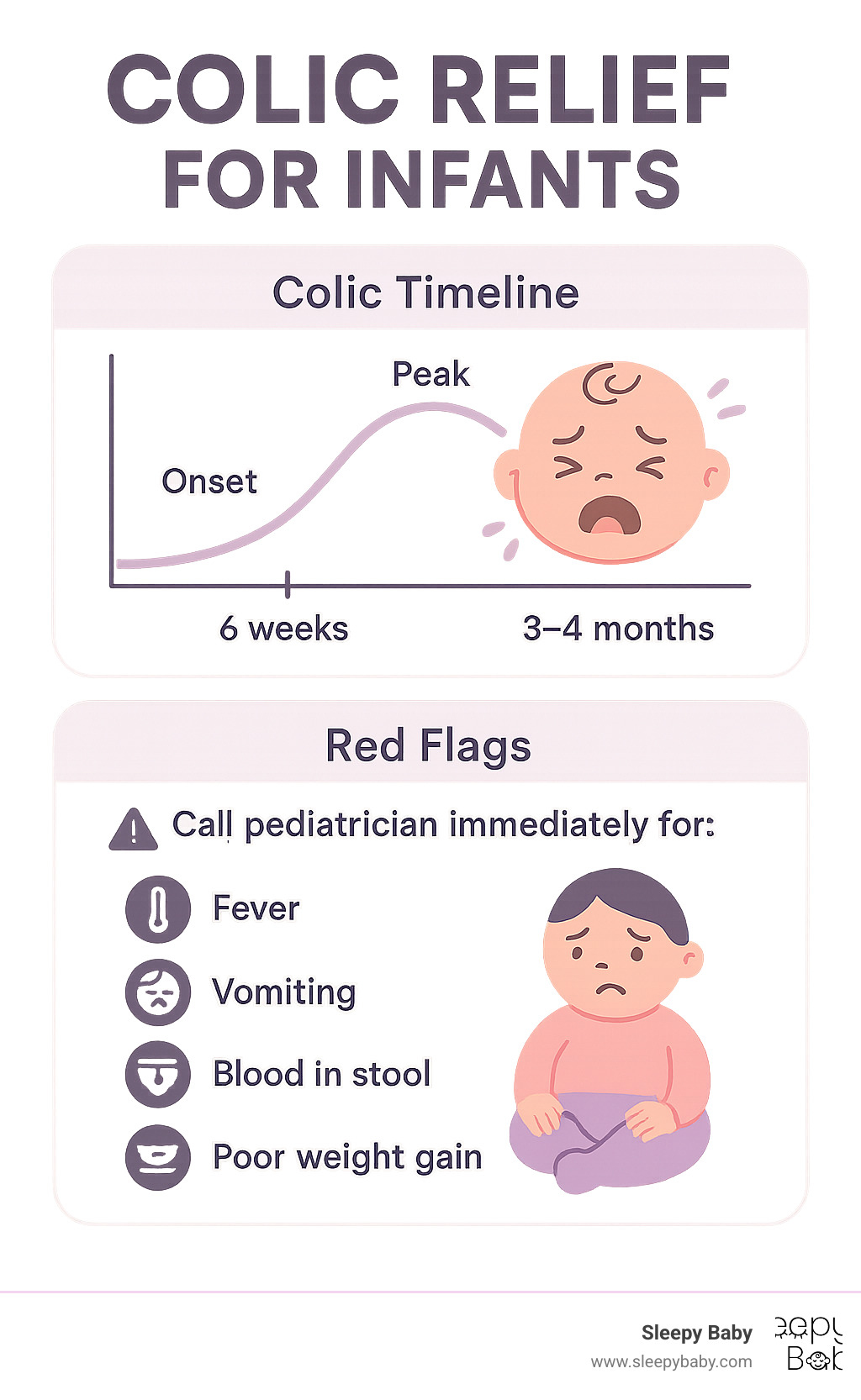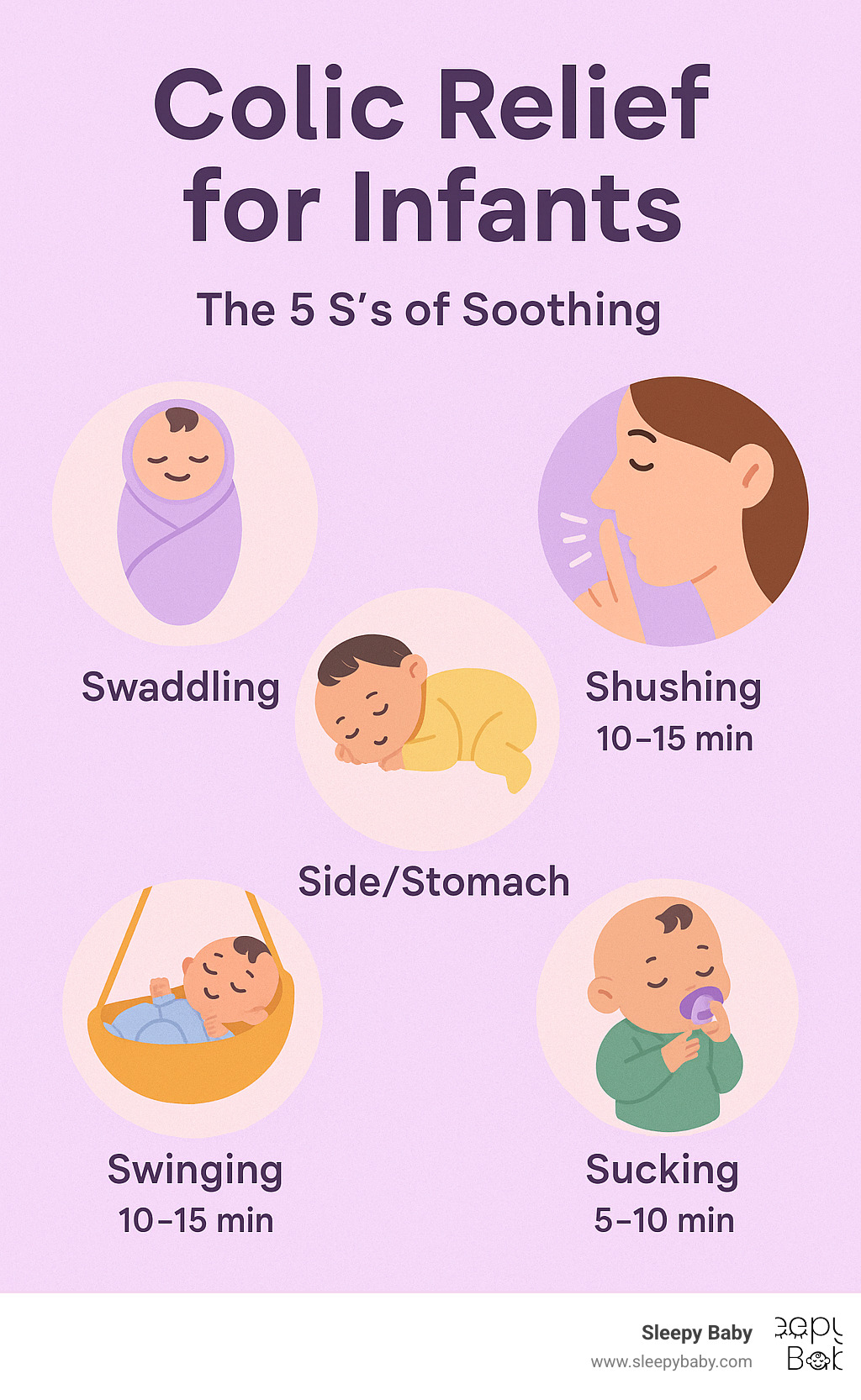Why Colic Relief for Infants Is Critical for Your Family's Well-Being
Colic relief for infants can feel like an impossible puzzle when you're facing hours of inconsolable crying every single day. If your baby cries for more than 3 hours a day, more than 3 days a week, for longer than 3 weeks - you're likely dealing with colic.
Quick Colic Relief Options:
- Swaddling - Wrap baby snugly in a thin blanket
- White noise - Use household sounds like vacuum or dryer
- Rhythmic motion - Rock, bounce, or walk at 60-70 beats per minute
- Tummy pressure - Hold baby face-down across your forearm
- Warm bath - Soothe with gentle water therapy
- Pacifier - Satisfy natural sucking reflex
Colic affects about 20% of all babies worldwide and typically peaks around 6 weeks of age. The good news? Up to 90% of colic cases resolve by 4 months of age.
This condition doesn't just affect babies - it impacts entire families. Research shows colic can increase the risk of postpartum depression and extreme caregiver stress. One study found that 17% of families seek professional help specifically for colic-related concerns.
As Gary Harutyunyan, I understand this struggle after experiencing sleepless nights with my own colicky newborn, which led me to develop innovative colic relief for infants solutions. My journey from desperate parent to creating the Sleepy Baby device taught me that combining evidence-based techniques with the right tools can transform those exhausting early months.

Understanding Infant Colic
When your baby cries inconsolably for hours despite being fed, changed, and comforted, you're likely facing one of parenthood's most exhausting challenges. Colic relief for infants becomes a desperate search when you realize this isn't just typical baby fussiness.
Colic affects somewhere between 10-40% of babies worldwide, making it surprisingly common yet still poorly understood. Research shows that formula-fed babies experience slightly higher rates of excessive crying, with 43% showing symptoms at 2 weeks compared to 16% of breastfed infants.
The condition appears to stem from multiple factors including immature nervous systems, gut microbiome imbalances, food intolerances, and overstimulation.
What Is Colic?
Medical professionals use Wessel's criteria to diagnose colic - the famous "rule of three." The Rome IV criteria help doctors distinguish colic from other conditions by looking for specific patterns. True colic involves paroxysmal crying episodes - sudden, intense bursts that seem to come out of nowhere in otherwise healthy babies.
During these episodes, your baby's cry sounds different. It's often higher-pitched and more intense than their usual hunger or discomfort cries. Your little one might draw their legs up toward their tummy, clench their fists tightly, and arch their back as if they're in real pain.
Excessive gas and bloating often accompany these crying spells. These episodes typically happen at predictable times, usually during the late afternoon or evening "witching hours" between 6 PM and midnight.
When Does It Start and End?
Colic has a fairly predictable timeline. Most cases begin between 2-4 weeks of age, peak around 6 weeks, and up to 90% of cases resolve completely by 3-4 months of age.
Understanding this natural progression can be emotionally lifesaving for exhausted parents. The resolution often happens gradually rather than suddenly. You might notice crying episodes becoming shorter, less intense, or skipping days entirely before disappearing completely.
Unfortunately, colic doesn't just affect babies - it impacts entire families. The constant crying can lead to sleep deprivation, increased risk of postpartum depression, and extreme caregiver stress.
Colic Relief for Infants: Proven Soothing Techniques
When your baby's cries pierce through the house for the third hour straight, you need proven techniques that actually work. The secret lies in understanding what your baby experienced for nine months in the womb. Colic relief for infants works best when we recreate those familiar sensations.

Dr. Harvey Karp's famous "5 S's" method has helped millions of families find relief. Swaddling recreates that snug womb feeling - wrap your baby firmly in a thin blanket. Side or stomach positioning (only while awake and supervised) can instantly calm a fussy baby. Shushing needs to be louder than your baby's crying to break through their distress. Swinging and rhythmic motion at 60-70 beats per minute matches your heartbeat. Sucking satisfies one of your baby's strongest reflexes.
The beauty of these techniques is that they work even better when combined. For more natural approaches that complement these methods, explore our Natural Harmony techniques.

Hands-Free Options for Colic Relief for Infants
You can't hold and bounce your baby for three hours straight every single day. Baby swings with variable speeds can provide that crucial rhythmic motion. Wearable carriers tap into something profound - babies who are carried regularly cry significantly less. Vibrating bouncer seats offer gentle motion that many colicky babies find irresistible. Stroller walks combine fresh air, motion, and a change of scenery. Car rides work like magic for many babies.
Our Sleepy Baby device represents the evolution of hands-free soothing. It combines intelligent rhythmic patting with customizable white noise, essentially giving you an extra pair of comforting hands when you need them most.
The Power of Touch & Massage
Recent research on infant massage has produced remarkable findings. A comprehensive study found crying episodes dropped by over 4 times per day, daily crying duration decreased by nearly 3 hours, and pain intensity scores improved dramatically.
Using 6-7 drops of baby-safe oil, gently massage your baby's abdomen in clockwise circles for about 5 minutes, three times daily. Olive oil massage has shown particularly impressive results, reducing crying duration by 65% and crying frequency by 57%.
Always warm your hands before starting, and pay attention to your baby's cues. The key is finding what works for your unique little one.
Feeding & Dietary Strategies for Colic Relief for Infants
What your baby eats and how they eat it can make a huge difference in their comfort levels. Feeding posture matters tremendously - keeping your little one upright during feeds helps reduce the amount of air they swallow.
Paced feeding is another game-changer. Instead of letting your baby gulp down their entire bottle, try taking breaks every 1-2 ounces. Feed every 2-2.5 hours with smaller amounts.
| Formula Type | Crying Reduction | Study Duration | Success Rate |
|---|---|---|---|
| Standard Formula | Baseline | - | - |
| Whey Hydrolysate | 63 minutes/day | 2 weeks | 65% |
| Casein Hydrolysate | 60-80 minutes/day | 2 weeks | 68% |
| Soy Formula | 13-16 hours/day | 1 week | 58% |
Hydrolyzed formulas can be particularly effective for colic relief for infants. These special formulas have proteins that are already broken down into smaller pieces, making them much easier for sensitive tummies to handle.
Probiotics, particularly L. reuteri, have shown promising results in clinical studies. For detailed information about probiotic effectiveness in colic management, refer to this scientific research on probiotic effectiveness.
Breastfeeding Adjustments
If you're breastfeeding, what you eat directly affects your baby through your breast milk. The most common culprit is dairy products. Clinical studies show that mothers following a low-allergen diet - removing dairy, eggs, nuts, soy, wheat, and fish - reduced their babies' crying by an impressive 137 minutes per day.
Eliminate one food at a time and give it a full two weeks to see results. Caffeine deserves special attention - limiting yourself to 1-2 cups daily can make a difference. Don't forget about gas-producing foods like beans, cabbage, broccoli, and onions.
For more information about potential side effects of various colic treatments, read our guide on colic drops and their side effects.
Formula-Fed Solutions
Protein hydrolysate formulas are often the first recommendation, where proteins are pre-digested into smaller pieces. Studies show these formulas can reduce crying time by 60-80 minutes per day.
The key to switching formulas is patience and gradual transition. Start by mixing 25% new formula with 75% of your current formula for the first two days. Pay attention to your bottle nipple flow and warm formula to body temperature for best results.
Evidence-Based Treatments & What to Avoid
When you're exhausted and desperate for colic relief for infants, it's tempting to try every product you can find. But only a handful of treatments actually have solid scientific research backing them up.
The probiotic Lactobacillus reuteri DSM 17938 stands out as one of the most promising treatments, reducing crying by 61 minutes per day in breastfed infants. Hydrolyzed formulas represent another evidence-based option, decreasing crying time by 60-80 minutes daily in formula-fed babies.
Fennel oil preparations have shown promise in smaller studies, with 65% of infants showing improvement. However, always consult your pediatrician before using any herbal remedies.
For comprehensive information about treatment effectiveness, you can review this scientific research on treatment efficacy.
But let's be honest about treatments with limited evidence. Simethicone (those gas drops you see everywhere) performed no better than placebo in rigorous trials. Gripe water lacks serious scientific testing. Chiropractic manipulation shows mixed results with no clear benefit.
What Works Best?
The most successful approach to colic relief for infants isn't about finding one magic solution - it's about creating a comprehensive strategy. You start with consistent soothing routines using proven methods like swaddling, white noise, and rhythmic motion. Then you optimize feeding practices through proper positioning and pacing.
For breastfed babies, adding targeted supplements like L. reuteri can provide additional relief, while formula-fed infants might benefit from switching to hydrolyzed proteins.
Treatments to Skip or Use with Caution
Some treatments you should avoid completely include dicyclomine, which is banned for infants under 6 months due to serious side effects. Excessive herbal teas might interfere with your baby's nutrition. Honey-containing products pose a real risk of botulism in infants under 12 months.
Unregulated supplements present quality and safety concerns. Spinal manipulation has limited evidence and carries potential risks. Essential oils can cause skin irritation in sensitive infants.
Remember: any treatment should be safer than the condition it's meant to treat. Since colic is ultimately harmless and resolves on its own, aggressive interventions with potential side effects simply aren't worth the risk.
Coping for Parents & When to Seek Help
Living with a colicky baby can push even the most patient parents to their breaking point. Research shows that colic significantly increases the risk of postpartum depression, relationship strain, and in extreme cases, shaken baby syndrome.

The hardest truth about colic relief for infants is that sometimes nothing works in the moment. Placing your baby in their crib and stepping away for 10–15 minutes is not only acceptable – it's necessary. Never hesitate to call family or friends for relief shifts.
The most critical safety rule: never shake your baby, no matter how desperate you feel. If you feel that urge rising, immediately put your baby in a safe place and call someone for help.
Call your pediatrician immediately if your baby develops a fever over 100.4 F (38 C), vomits blood, has blood in the stool, or shows signs of dehydration. Watch for changes in your baby's crying pattern too – if the crying sounds different or more intense than usual, or if your baby refuses to eat or shows poor weight gain.
For comprehensive strategies on managing the overwhelming challenges, our detailed guide on overcoming colic and sleep deprivation offers practical solutions.
Mental Health Matters
The psychological toll of colic extends far beyond temporary sleep deprivation. Parents of colicky babies experience higher rates of postpartum depression and anxiety – up to 45% compared to 15% in families with non-colicky babies.
Joining support groups can provide invaluable connection with other parents who truly understand. Partner teamwork becomes absolutely crucial – develop a clear rotation system so each parent gets adequate rest.
Professional counseling may become necessary if you experience persistent sadness, overwhelming anxiety, or any thoughts of harming yourself or your baby. Colic is temporary and not a reflection of your parenting abilities.
Frequently Asked Questions about Colic Relief for Infants
When should I see a pediatrician?
Trust your parental instincts – they're usually right. Red flag symptoms that require immediate medical attention include fever over 100.4 F (38 C), vomiting or blood in spit-up, blood in stool, or poor weight gain.
You should also seek medical care if your baby's crying pattern suddenly changes dramatically. Even without concerning symptoms, discussing colic relief for infants with your pediatrician can be incredibly helpful.
Can probiotics and simethicone be used together?
Yes, probiotics and simethicone can generally be used together safely, but always check with your pediatrician first. Probiotics, specifically L. reuteri, have solid evidence supporting their effectiveness in breastfed infants. Simethicone, on the other hand, hasn't shown significant benefits over placebo in rigorous studies.
If your pediatrician approves using both, space them apart by at least 30 minutes to avoid any potential interactions.
Does colic have any long-term effects on my baby?
Colic has no long-term negative effects on your baby's development, intelligence, or behavior. Your little one will develop completely normally, with no increased risk of behavioral problems later in childhood.
However, the stress of caring for a colicky baby can have lasting effects on families if not properly managed. This is why focusing on your family's well-being is just as important as finding effective colic relief for infants.
Conclusion
Finding effective colic relief for infants doesn't have to feel like an impossible mission. While every crying episode can test your patience, remember this crucial truth: colic is temporary. Up to 90% of cases resolve by 4 months of age.
The secret lies in combining proven approaches rather than searching for a single magic solution. Consistent soothing routines using swaddling and white noise work hand-in-hand with optimized feeding practices. When you add evidence-based supplements like L. reuteri for breastfed babies or hydrolyzed formulas for formula-fed infants, you create multiple pathways to comfort.
Don't expect overnight miracles. Most effective strategies take several days or even weeks to show their full benefits. Your baby's nervous system is still developing, and finding the right combination takes patience.
The most important person in this equation? You. Prioritizing your own mental health and seeking support isn't selfish - it's essential for your family's well-being.
For parents who want to explore additional tools, our guide on the best colic relief products for babies offers detailed insights into various support options.
At Sleepy Baby, we created our intelligent sleep aid device after experiencing the exhaustion of colic firsthand. Our technology provides rhythmic patting and customizable white noise - essentially giving you an extra set of comforting hands when you're running on empty. The device mimics a caregiver's soothing touch, allowing you to maintain consistent comfort for your baby while getting the rest you desperately need.
Using tools and seeking help doesn't mean you're failing as a parent. It means you're being smart and resourceful during one of parenting's toughest challenges. Colic tests every family, but with the right combination of techniques, support, and patience, you'll steer through this difficult phase and come out stronger on the other side.
Your baby's cries will eventually turn into coos, giggles, and peaceful sleep. Until then, be gentle with yourself and remember - you're doing better than you think.




